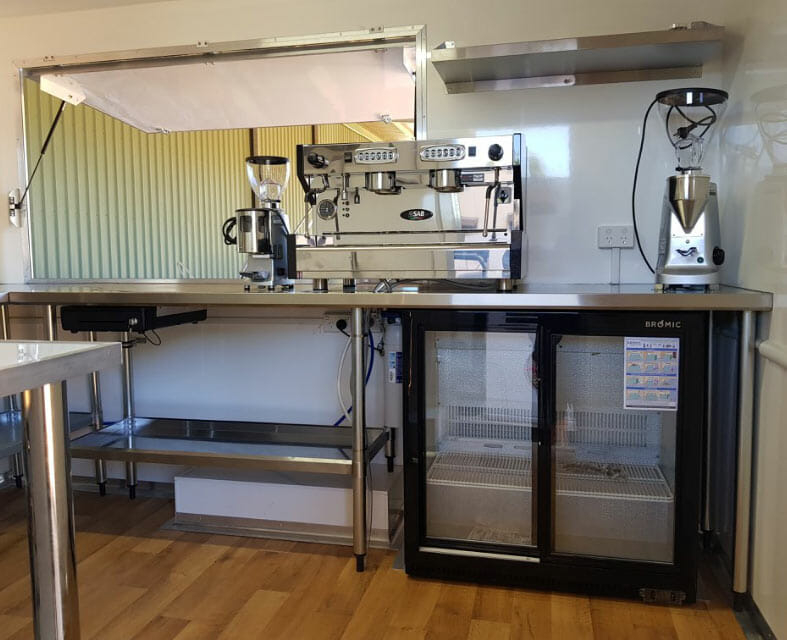
Designing Your Commercial Kitchen
The kitchen should be considered the heart of your restaurant or cafe. Factors that can determine the success of your restaurant/café, such as food quality, lead time and order efficiency rely heavily of the strategic design of your kitchen’s layout.
To optimise the flow of food production, commercial kitchens should not be using the same design principles of domestic kitchens, as they serve a completely different set of criteria.
Of the many fundamental aspects to consider when designing or refurbishing your commercial kitchen, we recommend first considering what your commercial kitchen will require. In most cases, you will need:
• Dry storage
• Refrigerated storage
• Freezer storage
• Food preparation station
• Designated cooking space
• Service area
• Dish pit/wash-up area
Helpful Tips
1. Research Local Health Codes
By obtaining the required permits for your food service operation, you’ll ensure your business has a firm foundation. Every state and local area has its own codes, so it’s best to familiarize yourself with them prior to designing your space. Topics such as ventilation, waste storage and lighting should be addressed in this stage of planning. A good starting point is the New Zealand Food Standards Code, which can be downloaded here. Alternately, you may enquire directly with your local public health department to find more information on applicable regulations for food service industries.
2. Know Your Menu
Creating processes to execute each dish will help shape your design in that it will determine which appliances and tools your kitchen requires. In this stage of planning, you can ensure your staff has ample counter space to work. For example, food preparation should be positioned between storage and the cooking area to achieve the ideal flow. When space permits, you should segregate preparation into different processes. Meaning, raw meat/fish prep, vegetable prep, poultry and desert will each have different preparation stations. Understanding the space and tools your kitchen requires will allow you to streamline food preparation processes. But if you find yourself in a tight situation and need help to create extra work space (most of us do), not to worry! Check out Brayco’s Stainless Steel Over Bench Shelves.
3. Involve the Chef & BOH Staff
A haphazardly designed kitchen ultimately creates obstacles for your chef and back-of-house team. When possible, involve your team in the design process so their skills and expertise may be utilised. Input from the kitchen and BOH staff will help you determine the ideal placement of appliances and kitchen tools, therefore creating a smooth kitchen flow that will make your cooking and clean-up routines seamless.
Choosing Your Layout
Different layouts suit different types of restaurants. Here we’ll look at the suitability standards for each type.
Which Floor Plan is Best for Fast Food?
Fast food outlets work best with a centralised strip serving the assembly line. The assembly-line configuration is ideal for kitchens that need to serve a large quantity of people quickly. Under this model, kitchen equipment is situated in a line with the food preparation station at one end and the service station on the other, which encourages the quick production of food by sending it down the line. This layout works particularly well for restaurants with a limited menu, such as pizza or sandwich shops.
Which Floor Plan is Best for Catering Businesses?
Kitchens used to cater events generally have varied menus comprised of multiple courses. The zone-style layout typically works best. Under this blueprint, each station has its own space which allows BOH staff to divide and conquer. Restauranteurs can simply employ a specialized chef to tackle each station. Each workstation should have its own allocated area which usually requires a large and open working kitchen space, so this model does not suit small kitchens.
Café: Small spaces with few staff members benefit from an open design. An open kitchen layout allows your team to maximise a small space. An increasingly popular model consists of a glass partition between the service area and guest seating, which allows guests to see all the action. You can even create a chef’s table by placing bar stools by the kitchen. This gives your guests a unique and special experience while you are maximizing your venue’s potential. It’s no surprise that small spaces can be tricky to fit out, which is precisely why Brayco carries such a wide range of products in a large number of sizes, with speciality ranges to fit corners and the narrowest spaces.
Which Floor Plan is best for Large Restaurants? The island-style commercial kitchen layout features a central “command centre” or passthrough point for all dishes, which facilitates constant communication between the chef, cooks, and BOH staff. The island-style design is typically comprised of cooking equipment at its centre, while storage units, food prep and washing stations are located along its perimeter. This set up is ideally suited for restaurants with lots of kitchen space.
Where to buy Commercial Kitchen Furniture
Brayco supplies commercial kitchen benches, sinks, cabinets, shelving systems and much more. Products are supplied flat pack for easy delivery. Assembly is a breeze and sales staff are on hand to give advice if needed.
With over 450 products, Brayco is sure to have what you need, as most products come in a variety of shapes and sizes with many customisable to suit your requirements.
It’s not hard to understand why so many restauranteurs are opting for stainless steel cabinetry, countertops and accessories – it’s super sleek, ultra-hygienic and enhances the overall look of your kitchen.
About Ordering from Brayco
Brayco deliver across New Zealand. You’ll find the showroom in Auckland, which you’re welcome to visit.
Office hours are as follows: Monday – Friday, 9 am – 5 pm.
Chrissy Hutching is your contact in the New Zealand office.
She’d be glad to share her expertise with you and has been helping Brayco’s New Zealand customers since 2008.







